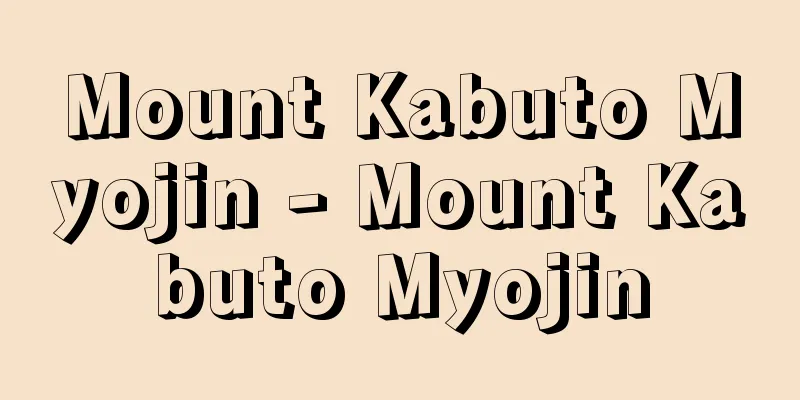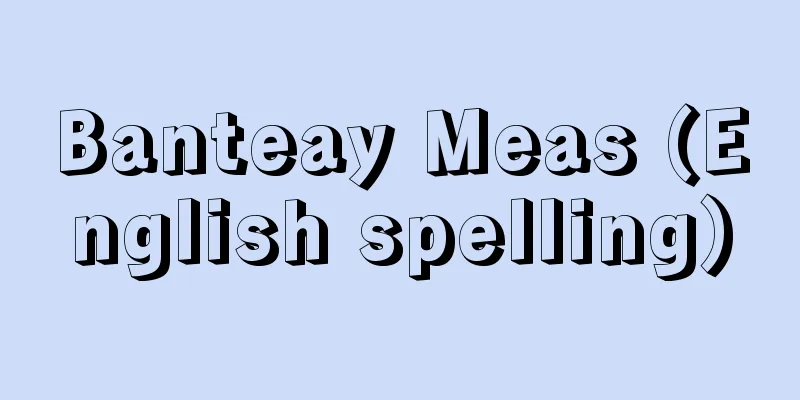Oda Nobunaga

|
A military commander in the Sengoku and Azuchi-Momoyama periods. He ended the turmoil of the Sengoku period and created the basis for national unification. [Osamu Wakita] Family lineageThe Oda clan is said to have been related to the Tsuda clan of Omi, but during the Muromachi period they served the Shiba clan, and were based in Oda-no-sho in Echizen (Fukui Prefecture), where they revered Oda Tsurugi Shrine as their clan deity. The Shiba clan entered Owari (Aichi Prefecture) as the deputy governor of Owari, due to their role as the guardian of Owari. Later, the Oda clan split into upper and lower Owari, but Nobunaga's family was the chief retainer of the deputy governor of the lower four counties. Nobunaga's father, Nobuhide, expanded his influence, and came to control southern Owari, centering on Shobata and Nagoya. Nobunaga was Nobuhide's third son. His childhood name was Kichihoshi. He came of age in 1546 (Tenbun 15) and was named Saburo Nobunaga. The following year, he went to Mikawa for his first campaign, then married the daughter of Saito Dosan of Mino, and inherited the family headship upon Nobuhide's death in 1551. He initially claimed the Fujiwara clan, but as the Muromachi Shogunate was of the Minamoto clan, he later claimed the Taira clan, in keeping with the idea of a Genpei alternation. He signed as Kazusa no Kami and Kazusa no Suke, but before entering Kyoto, he changed his central government position to Danjo no Chu. In his youth, he behaved unrestrainedly and preferred a strange style, and was described as a "fool." There was also an incident in which his old vassal, Hirate Masahide, was killed on a plea, and Nobunaga built Seishu-ji Temple to mourn his brother's soul. He surprised everyone by wearing formal attire when meeting his father-in-law, Dosan. His family crest was a quince tree, and he was allowed to use the paulownia crest by Shogun Ashikaga Yoshiaki. His flag was the Eiraku Tongbao coin. His horse crest was a Nanban hat. His red seal read "Tenka Fubu" (unify the world). [Osamu Wakita] battleNobunaga's life was filled with battles, first defeating Oda Nobutomo at Kiyosu Castle in 1555 (Koji 1) and making it his castle, then suppressing a rebellion by his younger brother Nobuyuki and others in 1557, and expelling Oda Nobukata, lord of Iwakura Castle, in 1559 (Eiroku 2), unifying Owari. The following year, in 1560, he defeated Imagawa Yoshimoto at the Battle of Okehazama, earning his military fame, and then allied with Tokugawa Ieyasu. He later focused on attacking Mino (Gifu Prefecture) from Komakiyama, and in 1567 he captured Inabayama Inokuchi Castle, expelling Saito Tatsuoki, changing it to Gifu and making it his castle. Nobunaga, who controlled both Owari and Mino, embarked on his journey to Kyoto in September 1568 accompanied by Ashikaga Yoshiaki. He pursued Rokkaku Yoshikata of Omi, who was trying to stop him, entered Kyoto, and pacified Kinai. Yoshiaki became Shogun, and Nobunaga took control of the country, but the battle with the warlords of the Sengoku period and the Hongan-ji Temple intensified. The following year, Nobunaga subjugated the Kitabatake clan of northern Ise, adopted his second son, Nobukatsu, and in 1570 (Genki 1), he fought against the Azai clan of northern Omi and the Asakura clan of Echizen at Anegawa, and fought against the Miyoshi Triumvirate in Settsu, and also fought against the Ishiyama Hongan-ji Temple. In 1571, they burned down Enryakuji Temple on Mount Hiei. Around this time, their conflict with Shogun Yoshiaki, with whom they had been on bad terms for some time, intensified, and in 1573 they expelled Yoshiaki and destroyed the Muromachi Shogunate. They then destroyed the Asakura and Azai clans. In 1575 (Tensho 3), they fought the Battle of Nagashino with Takeda Katsuyori of Kai, defeating him with the power of their artillery corps. In the Kinai region, they suppressed the defections of Matsunaga Hisahide and Araki Murashige, and in their confrontation with the most stubborn Ishiyama Honganji, they destroyed the rebel bases in Ise Nagashima, Echizen, and Saika, and in 1580 they made peace with Honganji and forced them to retreat from Ishiyama Castle. With this, Kinai was pacified, and Nobunaga smashed castles in Setsu, Kawa, and Izumiwa (the areas of Hyogo, Osaka, and Nara prefectures). Meanwhile, Akechi Mitsuhide pacified Tamba and Tango (the areas of Hyogo and Kyoto prefectures), Shibata Katsuie pacified Kaga, and Hashiba Hideyoshi (Toyotomi Hideyoshi) attacked the Chugoku Mori region, and finally, in 1582, he destroyed his arch-rival, the Takeda clan. In his later years, Nobunaga conquered almost the central part of Honshu, from Kai (Yamanashi Prefecture) and Shinano (Nagano Prefecture) in the east, Ecchu (Toyama Prefecture) and Noto (Ishikawa Prefecture) in the north, and Hoki (Tottori Prefecture) and Bitchu (Okayama Prefecture) in the west. On the early morning of June 2, 1581, before the decisive battle with the Chugoku Mori clan, he was killed at Honno-ji Temple (Shijo Nishinotoin) in Kyoto by his vassal Akechi Mitsuhide in rebellion (his eldest son Nobutada also committed suicide at the Nijo Imperial Palace at this time). He was buried at Sogen-in Temple in Murasakino Daitoku-ji Temple (Kita Ward). His posthumous name was Sogen-in Taigan'anko. There is also a grave at Amidaji Temple (Kamigyo Ward) where the ashes of Nobunaga and his son are said to have been collected and buried, and at Honnoji Temple (Nakagyo Ward, relocated after the incident) is Nobunaga's main mausoleum. [Osamu Wakita] Samurai powerNobunaga's direct territories were Owari, Mino, and Omi (Shiga Prefecture), and when he handed over his family headship to Nobutada, he also handed over Owari and Mino. As for central power, the Muromachi Shogunate was re-established immediately after his entry into Kyoto, and in the Kinai region, people related to the Shogunate became Shugo, so Nobunaga did not have much formal authority and ruled by force. He fell out with Yoshiaki, and after several years of infighting, he brought down the Shogunate. After that, Nobunaga inherited the power of the Shogun, and took control of the country in both name and reality, appointing Murai Sadakatsu as Kyoto Shoshidai, and seizing control of regional areas such as Shugo, appointing Araki to Settsu, and Harada Naomasa to Yamashiro and Yamato. Next, warlords such as Shibata Katsuie, Akechi Mitsuhide, Hashiba Hideyoshi, and Takigawa Kazumasu were given fiefs in various regions, and were given spheres of control over the Oda clan, and were put in charge of military corps. In the organization of vassals, the most powerful warlords became otomo and shukuro, and magistrates were placed in cities such as Azuchi, and in military and administrative units. As for military forces, there were horse guards, and groups of archers, spears, and gunmen. The gunmen were particularly excellent. For military mobilization, vassals took part in battles, leading numbers determined by mutual contract. In addition, armies were formed by combining the military forces of the warlord who acted as the immediate commander with the military forces of other warlords as yoriki. [Osamu Wakita] Relationship with the Imperial Court and temples and shrinesNobunaga initially declined official positions at the Imperial Court, but in 1575 (Tensho 3), he became Junior Third Rank Gon Dainagon (Gon Dainagon) and Ukon'e Daisho (General of the Right Guard), handed over the family headship to Nobutada, and thereafter acted as a ruler of Japan, staying in Azuchi Castle. He became Minister of the Interior and then Junior Second Rank Minister of the Right in 1577, but eventually resigned and declined until the end. This was because he intended to take up prominent positions after unifying the country, and in his relationship with the Imperial Court, he adopted Emperor Ogimachi's Crown Prince, Prince Sanehito, as his adopted son (a child adopted without the purpose of inheritance), showed the Emperor a parade of horses, and built a room for imperial visits in Azuchi Castle (construction began in 1576, completed in 1579). Although the government burned down rebellious temples and shrines such as Enryaku-ji Temple, it generally provided a certain degree of protection to influential temples, shrines, and nobles, by assuring them of the rights to the lands and lands they currently held, and by implementing virtuous policies to restore their territories and promote the acquisition of new lands. [Osamu Wakita] Economic PolicyIn land policy, he made efforts to grasp the land through land surveys and land surveys. Ise, Owari, and Mino used the kanko system, while the Kinai and neighboring provinces used the koku daka system, and there was no unification of this system. However, it is noteworthy that he unified the land value indication on a province-by-province basis, grasped the annual tax yield, consolidated the basis of the chigyo, and determined the peasants as the ones responsible for the tax burden. Compared to Hideyoshi's Taiko land survey, there were differences in that the koku daka included millet and was not unified with rice, the daka indicated the amount of annual tax and was not based on production, some land survey books recorded the stipends of peasants, and the separation of soldiers and farmers was not thorough, and the exploitation of village headmen and peasants was not denied, and "naitokukomononari" was recognized. In terms of urban commercial policy, he abolished checkpoints in the provinces to facilitate smooth circulation, and issued an order to select coins with a broad perspective that included gold and silver coins, in an attempt to organize the currency. In the castle town of Azuchi, he implemented preferential policies such as free markets, free courts, and licenses for public business, striving for prosperity. As for the cities, he burned Kamigyo and Amagasaki, and disarmed Sakai and others, but did not completely deny the autonomy of cities, and recognized the privileges of temple towns. Generally speaking, he implemented the most progressive policies among the Sengoku daimyo, such as abolishing checkpoints and implementing castle town policies. In his domain of Omino, he controlled merchants by appointing Ito Sojuro as merchant governor, and outside of castle towns, he recognized za organizations and actively made use of distribution associations. Here too, the Imperial Family's territorial divisions in the seven districts of Kyoto were left in place, and the construction of temple towns within the city was permitted, all because the relationship with the nobles, temples, and shrines was respected. It is also known that, focusing on the economic power of the city, the Imperial Family formed ties with wealthy merchants from Sakai, such as Imai Sokyu and Tsuda Sokyu. [Osamu Wakita] Cultural PolicyNobunaga was a Zen Buddhist, but was also said to be an atheist, and placed political power above all else. This was shown by the fact that he held a sectarian debate between the Jodo sect and the Nichiren sect at Azuchi Castle, and condemned the latter. He showed no mercy to those who resisted, as seen in the burning of Enryaku-ji Temple and Makio-dera Temple on Mount Hiei, the assassination of the Koyasan saint, and the complete suppression of the Ikko-ikki uprising. As for Christianity, he gave it protection due to his interest in European culture and his opposition to the Ikko-ikki uprisings, and he allowed the construction of a seminary in Azuchi and a Nanbanji temple in Kyoto. He also liked sumo wrestling, and in the performing arts, he was fond of the Kōwakamai dance, and on the morning before leaving for the Battle of Okehazama, he famously performed a line from his favorite work, Atsumori, to the tune of "A human life lasts fifty years, but compared to the eternity of the world, it is like a dream..." He also loved to recite short poems, and is said to have loved to recite the lyrics, "Death is certain, what can we do with the grass that hides, but we can only tell a certain story." In the tea ceremony, he employed Sen no Rikyu, Tsuda Soeki, Imai Sokyu, and others as tea masters, and gathered famous people, but he also used the tea ceremony for political purposes, giving the honor of allowing meritorious vassals to perform the tea ceremony and giving them tea utensils. [Osamu Wakita] Historical locationNobunaga emerged during the transition from the Middle Ages to the early modern period, and fell just before he could put an end to the turmoil of the Sengoku period. In that sense, he was certainly the front-runner in unifying the power of the early modern period. However, opinions are divided on the assessment of the Oda government. Traditionally, the prevailing theory was that the Oda government was a modern power, lumped together with the Azuchi-Toyotomi government, and that it was a continuation of the Toyotomi government. Recent research defines the Oda government as a central power at the Sengoku daimyo stage, and that although it is much newer than the Muromachi shogunate, it is different from early modern powers such as the Toyotomi government. [Osamu Wakita] "Oda Nobunaga" by Suzuki Ryoichi (Iwanami Shinsho)" ▽ "Oda Nobunaga" by Imai Rintaro (1966, Chikuma Shobo)" ▽ "A Study on the History of the Establishment of Feudalism in the Early Modern Period" by Wakita Osamu (1977, University of Tokyo Press) [References] | |"Portrait of Oda Nobunaga" Reproduction (partial) owned by the Historiographical Institute, University of Tokyo © Historiographical Institute, University of Tokyo "> Oda Nobunaga ©Shogakukan "> Summary of Oda Nobunaga's Relationships From the right: flag, mother's robe, horse brand, mother's robe. "Goumajirushi" Volume 4, Kan'ei era (1624-1644), owned by the National Diet Library . Joinery and horse banners of Oda Nobunaga ©Shogakukan "> Oda Nobunaga's signature A red seal letter addressed to Shinano Hyobu no Jō. The seal "Tenka Fubu" can be seen. 1573 (Tenshō 1). Copy held at the National Diet Library . Oda Nobunaga's red seal letter Source: Shogakukan Encyclopedia Nipponica About Encyclopedia Nipponica Information | Legend |
|
戦国・安土桃山(あづちももやま)時代の武将。戦国動乱を終結し全国統一の前提をつくった。 [脇田 修] 家系織田氏は近江(おうみ)津田氏と関係があると伝えられているが、室町期斯波(しば)氏に仕え、越前(えちぜん)(福井県)織田荘(おだのしょう)を根拠とし織田劔神社(つるぎじんじゃ)を氏神と崇敬した。斯波氏が尾張(おわり)守護の関係で尾張守護代として尾張(愛知県)に入る。のち上・下尾張に織田氏も分かれるが、信長の家は下四郡守護代家の家老であった。信長の父信秀(のぶひで)が勢力を伸ばし、勝幡(しょばた)・那古野(なごや)を中心に尾張南部などを支配する。信長は信秀の三男。幼名は吉法師(きちほうし)。1546年(天文15)元服して三郎信長。翌年三河へ初陣、ついで美濃(みの)斎藤道三(さいとうどうさん)の娘と結婚、1551年信秀の死とともに家督を嗣(つ)いだ。初め藤原氏を称したが、室町幕府が源氏であるため、源平交替思想から、のち平氏を称す。上総守(かずさのかみ)、上総介(かずさのすけ)と署名するが、入洛(にゅうらく)を前に弾正忠(だんじょうのちゅう)と中央官職に変える。若いころの行状は奔放で異様な風体を好み「うつけ」と評された。老臣平手政秀(ひらてまさひで)が諫死(かんし)する事件もあり、信長は、政秀寺(せいしゅうじ)を建立して菩提(ぼだい)を弔っている。舅(しゅうと)道三との対面に正式の服装をして人々を驚かせる。家紋は窠(か)(木瓜(もっこう))、将軍足利義昭(あしかがよしあき)より桐(きり)の紋を許される。旗差物(はたさしもの)は永楽通宝(えいらくつうほう)。馬印(うまじるし)は南蛮笠(なんばんがさ)。朱印は「天下布武(てんかふぶ)」などを用いる。 [脇田 修] 戦闘信長の生涯は戦闘に明け暮れたが、まず、1555年(弘治1)清洲城(きよすじょう)織田信友を討ってここを居城とし、1557年弟信行らの反乱を抑え、1559年(永禄2)岩倉城主織田信賢(のぶかた)を追放して尾張を統一した。翌1560年桶狭間(おけはざま)の戦いで今川義元(いまがわよしもと)を倒して武名をあげ、ついで徳川家康と同盟した。のち、小牧山を居城として美濃(岐阜県)攻めに力を入れ、1567年稲葉山井ノ口城攻略、斎藤龍興(さいとうたつおき)を追放、これを岐阜と改め居城とする。尾張、美濃をあわせた信長は、1568年9月足利義昭を奉じて上洛の途につき、これを阻もうとする近江(おうみ)六角義賢(ろっかくよしかた)を追い、入洛、畿内(きない)を鎮定。義昭は将軍となり、信長は天下の実権を握るが、戦国群雄、本願寺との戦いが激化する。翌年、信長は北伊勢(きたいせ)北畠(きたばたけ)氏を屈伏させ、二男信雄(のぶかつ)を養子に入れ、1570年(元亀1)北近江浅井、越前(えちぜん)朝倉と姉川(あねがわ)に戦い、摂津で三好三人衆(みよしさんにんしゅう)を迎え撃ち、石山本願寺との合戦も起こる。1571年比叡山(ひえいざん)延暦寺(えんりゃくじ)を焼討ち。このころ、先に不和となっていた将軍義昭との対立が激しくなり、1573年義昭を追放、室町幕府を滅亡させた。ついで朝倉・浅井両氏をも滅ぼした。1575年(天正3)甲斐(かい)武田勝頼(たけだかつより)と長篠合戦(ながしのかっせん)があり鉄炮隊(てっぽうたい)の威力で撃破。畿内では松永久秀、荒木村重の離反を押さえ、もっとも頑強であった石山本願寺との対決は、伊勢長島、越前、雑賀(さいか)と一揆(いっき)の拠点をつぶしたのち、1580年本願寺と和睦(わぼく)、石山から退城させた。これにより畿内は平定され、信長は、摂河泉和(兵庫県、大阪府、奈良県一帯)で城破りを行う。その間にも明智光秀(あけちみつひで)の丹波(たんば)・丹後(たんご)(兵庫県、京都府一帯)平定、柴田勝家(しばたかついえ)による加賀平定、羽柴秀吉(はしばひでよし)(豊臣秀吉(とよとみひでよし))の中国毛利(もうり)攻めが進み、ついに1582年には宿敵武田氏を滅ぼす。信長の晩年には、東は甲斐(山梨県)、信濃(しなの)(長野県)、北は越中(えっちゅう)(富山県)、能登(のと)(石川県)、西は伯耆(ほうき)(鳥取県)、備中(びっちゅう)(岡山県)と、ほぼ本州の中央部を征服し、中国毛利氏との決戦を前に天正(てんしょう)10年6月2日未明、家臣明智光秀の謀反により京都本能寺(四条西洞院(にしのとういん))で倒れた(長男信忠(のぶただ)も、このとき二条御所にあって自刃)。紫野(むらさきの)大徳寺(北区)総見院に葬る。法号総見院泰巌安公。信長父子の骨灰を集めて葬ったという墓が阿弥陀寺(あみだじ)(上京(かみぎょう)区)にもあり、本能寺(中京(なかぎょう)区、変後移転)には信長本廟(ほんびょう)がある。 [脇田 修] 武家権力信長の直属分国は尾張、美濃、近江(滋賀県)で、家督を信忠に譲ったとき、尾張、美濃も渡している。中央権力としては、入洛直後は室町幕府が再建され、畿内では幕府関係者が守護となったように、信長の正規の権限はあまりなく、実力支配体制をとった。義昭と不和になり、数年の暗闘ののち、幕府を滅亡させた。その後、信長は将軍権力を継承し、名実ともに天下を握り、京都所司代(しょしだい)に村井貞勝(むらいさだかつ)を任命、守護などの地域支配権を掌握し、摂津に荒木、山城(やましろ)・大和(やまと)に原田直政(はらだなおまさ)らを任命した。ついで柴田勝家、明智光秀、羽柴秀吉、滝川一益(たきがわかずます)らの武将が各地に封じられ、それが織田家の支配圏をゆだねられるとともに、軍団を率いた。家臣団組織は、おとな・宿老に先の有力武将がなり、奉行(ぶぎょう)が安土などの都市と、軍事・行政単位に置かれた。軍事力は親衛隊として馬廻(うままわり)の士、弓・槍(やり)・鉄炮の組が存在した。とくに鉄炮隊は優れていた。軍事動員は相対(あいたい)契約で決めた人数を率いて家臣が参陣した。また、当面の司令官たる武将の直属軍事力に、与力(よりき)として他の武将の軍事力を組み合わせて軍団を構成した。 [脇田 修] 朝廷・寺社との関係信長は初め朝廷の官職を辞退したが、1575年(天正3)従三位(じゅさんみ)権大納言(ごんだいなごん)兼右近衛大将(うこんえだいしょう)となり、家督を信忠に譲り、その後、天下人として行動、安土城にいる。内大臣次いで1577年に従二位右大臣となるが、やがて辞官、最後まで辞退した。これは、天下平定ののち顕職につくとの理由であり、朝廷との関係では正親町天皇(おおぎまちてんのう)の東宮誠仁親王(さねひとしんのう)を猶子(ゆうし)(相続を目的としない養子)とし馬揃(うまぞろ)えを天皇にみせ、安土城(1576年着工、1579年完成)に行幸の間をつくるなどした。公家(くげ)・寺社とは、反抗した延暦寺などを焼討ちはしたものの、一般には、有力な寺社・公家が現に知行(ちぎょう)している土地や座の権益は安堵(あんど)し、徳政を行って知行の回復を図り、新地を進めるなど、一定の保護を行った。 [脇田 修] 経済政策土地政策では指出(さしだし)・検地(けんち)を行い土地把握に努めた。伊勢、尾張、美濃は貫高制、畿内近国は「石(こく)」高(だか)制であり、統一されていなかった。しかし、一国単位で土地の高表示を一元化し、その年貢収量を把握して、知行の基礎を固め、年貢負担責任者としての百姓を確定したことは注目しうる。これを秀吉の太閤検地(たいこうけんち)に比べると、「石」高も稗(ひえ)などを含んでいて米に統一されていないこと、高は年貢高を表示し、生産高を前提にしていないこと、検地帳に給人知行(きゅうにんちぎょう)が記されるものがあり、兵農分離が不徹底であること、名主百姓(みょうしゅびゃくしょう)の中間搾取は否定されず、「内徳小物成(ないとくこものなり)」を認められていること、などの違いがあった。都市商業政策では、分国における関所を撤廃して流通を円滑にし、金銀貨をも含む広い視野から撰銭令(えりぜにれい)を出して通貨整備を行おうとした。また城下町安土では楽市(らくいち)・楽座(らくざ)、公事免許(くじめんきょ)などの優遇策を実施して繁栄に努めた。都市については上京(かみぎょう)、尼崎(あまがさき)を焼き、堺(さかい)などの武装を解除したが、都市自治権は全面的には否定せず、寺内町(じないまち)の特権は認めたりしている。全般的にいえば関所撤廃、城下町政策など戦国大名のなかでも、もっとも進んだ政策を実施した。また領国尾濃では伊藤宗十郎(いとうそうじゅうろう)を商人司として商人統制を行い、城下町以外では座組織を認め、流通仲間など積極的に利用した。ここでも京七口(きょうななくち)の皇室領率分関(りつぶんぜき)を残し、座を認め、寺内町の建設すら認めたのは、公家・寺社との関係を尊重したためであった。都市の経済力に注目し、今井宗久(いまいそうきゅう)、津田宗及(つだそうきゅう)ら堺の豪商と結び付いたことも知られる。 [脇田 修] 文化政策信長は禅宗であるが、無神論者といわれるようなところがあり、なによりも政治権力を宗教勢力の上に置いた。浄土宗、日蓮宗(にちれんしゅう)の宗論を安土城で行わせ、日蓮宗を非としたことはそれを示している。比叡山延暦寺や槇尾寺(まきのおでら)焼討ち、高野聖(こうやひじり)斬殺(ざんさつ)、一向一揆(いっこういっき)の徹底的弾圧など、抵抗する者には容赦しなかった。キリスト教については、ヨーロッパ文化への興味と一向一揆との対抗のために保護を加え、安土にセミナリオ、京都に南蛮寺(なんばんじ)の建設を認めている。また相撲を好み、芸能では幸若舞(こうわかまい)をたしなみ、桶狭間合戦に赴く朝、かねて好む『敦盛(あつもり)』の一節「人間五十年、下天(げてん)の内をくらぶれば夢幻(ゆめまぼろし)の如(ごと)くなり……」と舞ったのは有名。小歌も口ずさみ、「死のふは一定(いちじょう)、しのび草には何をしよぞ、一定かたりをこすよの」の歌詞を愛誦(あいしょう)したという。茶の湯では千利休(せんのりきゅう)、津田宗及、今井宗久らを茶道(さどう)として召し抱え、名物をも集めたが、茶の湯を政治に利用し、功績のある家臣に茶の湯を許す栄誉を与え、茶道具を与えたりした。 [脇田 修] 歴史的位置中世から近世への変革期に現れ、戦国動乱を平定する直前で信長は倒れた。その意味で、彼が近世統一権力の先頭走者であったことは確かである。しかし、織田政権の評価については意見が分かれている。従来は、織豊政権(しょくほうせいけん)と一括されるように、織田政権を近世権力と考え、豊臣政権と連続してとらえる説が有力であった。最近の研究では、織田政権を戦国大名段階の中央権力と規定し、室町幕府よりもはるかに新しいが、豊臣政権のような近世権力とは異なると考えられている。 [脇田 修] 『鈴木良一著『織田信長』(岩波新書)』▽『今井林太郎著『織田信長』(1966・筑摩書房)』▽『脇田修著『近世封建制成立史論』(1977・東京大学出版会)』 [参照項目] | |「織田信長画像」 東京大学史料編纂所所蔵模写(部分)©東京大学史料編纂所"> 織田信長 ©Shogakukan"> 織田信長関係要図 右から、幟、母衣、馬印、母衣。『御馬印』 巻4 寛永年間(1624~1644)国立国会図書館所蔵"> 織田信長の指物と馬印 ©Shogakukan"> 織田信長花押 信濃兵部丞にあてた朱印状。「天下布武」印がみられる。1573年(天正1) 写国立国会図書館所蔵"> 織田信長の朱印状 出典 小学館 日本大百科全書(ニッポニカ)日本大百科全書(ニッポニカ)について 情報 | 凡例 |
Recommend
Myotis myotis (English spelling) Myotismyotis
…[Yoshiyuki Mizuko]. . . *Some of the terminology...
Kaplan, K.
…Usually, the runner blades are opened and closed...
RV Tauri - RV Tauri
...Long-period variables are the stars with the l...
Uzbekistan - Republic of Uzbekistan (English spelling)
A republic located in Central Asia. It was former...
IES
...A sonic wave gauge is installed on the ocean f...
SC material - SC materials
...steel used for functional parts of machines th...
Goodyera foliosa (English spelling) Goodyerafoliosa
… [Ken Inoue]. … *Some of the terminology that me...
Keesh - Keesh
...After the Abbasid Caliphate declined in the 10...
Morpheme - morpheme
A linguistic term that refers to the smallest for...
Iizuna Gongen
...In 1965, the Bird Line toll road connecting Na...
Samegawa [Village] - Samegawa
A village in Higashi Shirakawa District, southeast...
Tenninsou (Celestial grass) - Tenninsou (English spelling) Comanthosphace japonica
A perennial plant of the Lamiaceae family. It is d...
Waldglas
…After the 17th century, when Bohemian Baroque gl...
Extant star - Extant star
The Japanese name for the lacquerware technique c...
Carrier-based aircraft - Kansai (English spelling)
A type of military aircraft. It is carried on a wa...









